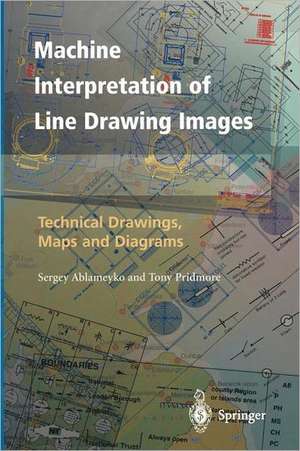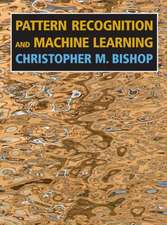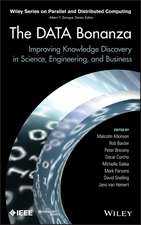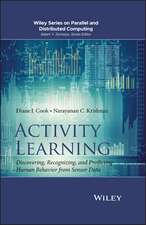Machine Interpretation of Line Drawing Images: Technical Drawings, Maps and Diagrams
Autor Sergey Ablameyko, Tony Pridmoreen Limba Engleză Paperback – 17 sep 2011
- describes the theory and practice underlying the computer interpretation of line drawing images and
- shows how line drawing interpretation systems can be developed.
The authors show how many of the problems can be tackled and provide a thorough overview of the processes underpinning the interpretation of images of line drawings.
Preț: 645.65 lei
Preț vechi: 807.05 lei
-20% Nou
Puncte Express: 968
Preț estimativ în valută:
123.56€ • 128.52$ • 102.01£
123.56€ • 128.52$ • 102.01£
Carte tipărită la comandă
Livrare economică 14-28 aprilie
Preluare comenzi: 021 569.72.76
Specificații
ISBN-13: 9781447112020
ISBN-10: 1447112024
Pagini: 300
Ilustrații: XII, 292 p.
Dimensiuni: 155 x 235 x 16 mm
Greutate: 0.42 kg
Ediția:Softcover reprint of the original 1st ed. 2000
Editura: SPRINGER LONDON
Colecția Springer
Locul publicării:London, United Kingdom
ISBN-10: 1447112024
Pagini: 300
Ilustrații: XII, 292 p.
Dimensiuni: 155 x 235 x 16 mm
Greutate: 0.42 kg
Ediția:Softcover reprint of the original 1st ed. 2000
Editura: SPRINGER LONDON
Colecția Springer
Locul publicării:London, United Kingdom
Public țintă
ResearchCuprins
1. The Line Drawing Interpretation Problem.- 1.1 Motivation.- 1.2 Manual Input vs Document Scanning.- 1.3 Raster-Based vs Vector Representations.- 1.4 The Interpretation Problem.- 1.5 Engineering Drawings and Maps.- 1.6 Line Drawing Interpretation, Image Understanding and Pattern Recognition.- 1.7 Current Line Drawing Interpretation Systems.- 1.8 The Line Drawing Interpretation Literature.- 2. Components of a Line Drawing Interpretation System.- 2.1 Design Criteria for Drawing Interpretation Systems.- 2.2 Five Stages of Line Drawing Interpretation.- 2.3 Intermediate and Target Representations.- 2.4 System Architectures and the Role of A Priori Knowledge.- 3. Document Image Acquisition.- 3.1 Scanning Devices.- 3.2 Image Coding.- 3.3 Image File Formats.- 4. Binarisation.- 4.1 A Taxonomy of Thresholding Techniques.- 4.2 Document Image Statistics.- 4.3 Binarising Line Drawings.- 5. Binary Image Processing and the Raster to Vector Transformation.- 5.1 Raster to Vector Conversion.- 5.2 Some Definitions.- 5.3 The Distance Transform.- 5.4 Mathematical Morphology.- 5.5 Reducing Noise in Binary Images.- 5.6 Reducing Noise in Binary Images of Line Drawings.- 6. Analysis of Connected Components.- 6.1 Nomenclature.- 6.2 Contouring.- 6.3 Skeletonisation.- 6.4 Grey Level Skeletonisation.- 7. Vectorisation.- 7.1 Approaches To Vectorisation.- 7.2 Global Vectorisation Methods.- 7.3 Local Vectorisation Methods.- 7.4 The Hough Transform.- 7.5 Direct Vectorisation.- 7.6 A Vector Database.- 7.7 Removing Noise from the Vector Model.- 7.8 Alternative Raster to Vector Technologies.- 8. Interpreting Images of Maps.- 8.1 Introduction.- 8.2 System Overview.- 8.3 Map Interpretation Principles.- 8.4 A Classification of Map Entities.- 8.5 Interactive Map Interpretation.- 8.6 Output Formats.- 8.7 Quality Issues.- 9. Recognising Cartographic Objects.- 9.1 Recognising Isolines.- 9.2 Recognising Roads.- 9.3 Recognising Texture and Area Objects.- 9.4. Recognising Symbols.- 10. Recovering Engineering Drawing Entities from Vector Data.- 10.1 Design Principles and System Architecture.- 10.2 Vectorisation and Entity Recognition Processes.- 10.3 Extracting Arcs and Straight Lines.- 10.4 Recognising Crosshatched Areas.- 10.5 Recognising Dimensions.- 10.6 Detecting Blocks.- 11. Knowledge-Directed Interpretation of Engineering Drawings.- 11.1 An Image Understanding Approach.- 11.2 Drawing Entities as Schemata.- 11.3 Image Analysis Facilities.- 11.4 The ANON Architecture.- 11.5 Control Issues.- 11.6 Entity Extraction: Chained Lines.- 11.7 Top-Down and Bottom-Up Control.- 11.8 Performance.- 11.9 Scene Formation.- 11.10 ANON in Context.- 11.11 Discussion.- 12. Current Issues and Future Developments.- 12.1 Higher-Level and 3D Representations.- 12.2 Exploiting Domain Knowledge.- 12.3 The Role of the Operator.- 12.4 Performance Measures.- 12.5 Topics for Future Development.- References.










